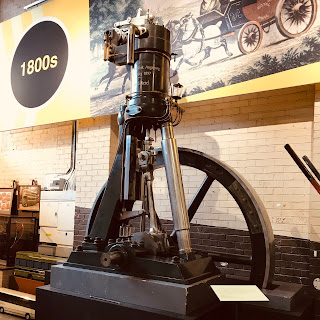Realise that according to the contemporary commercial ethos grand developments are supposed to sacrifice the family to the greater good of progress, but at my age there's a different perspective and it being a holiday weekend there's a museum for us to visit.
The Commercial Vehicle Museum is situated in Leyland, in the county of Lancashire here in the UK. It was not just historically bound up with aircraft manufacture but with that of omnibuses, steam wagons and later diesel-powered lorries (or trucks).
In fact at some time, given it was grist to their mill, they acquired Rudolf Diesel's original prototype. It looks big, but current marine Diesel engines are altogether bigger. This unit, given its preponderance in moving the world's goods around on land and sea, has probably advanced the cause of globalism more than either war or words.
It was from a vessel on the English Channel that Diesel disappeared, never to be seen again.
He was thought to have suffered the same fate as the inventor of nylon (suicide), but there is a good deal of support nowadays for the suggestion that he might have been the victim of a nascent 'big oil' lobby. Reason simple: his engine could run on practically any combustible fluid and at the time he was supposed to have been promoting the use of vegetable oil. Or peanut oil, if memory serves.
I recall the earliest venture toward resurrecting EVs in California in the 1980s, which was comprehensively trashed by big oil. And fans of Netflix documentaries will know that anyone making any plausible attempt to derive energy from plain water in lieu of oil turns out to have been 'lost' or indirectly threatened in similar circumstances in both the UK and US.
The only way around this is (a) to make lots of money and (b) make a noise and therefore despite its best efforts, the same lobby has been unable to make much of an impact on the sainted Elon, who may come to be viewed as having done for electrical road and air vehicles what Diesel did for those on roads and sea.







